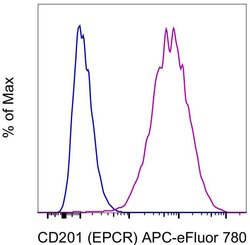Learn More
Invitrogen™ CD201 (EPCR) Monoclonal Antibody (eBio1560 (1560)), APC-eFluor™ 780, eBioscience™, Invitrogen™
Rat Monoclonal Antibody
Supplier: Invitrogen™ 47201282

Description
Description: The eBio1560 monoclonal antibody reacts with mouse Endothelial Protein C Receptor (EPCR, CD201), a 25 kDa Type 1 transmembrane protein expressed on endothelial cells. EPCR exhibits sequence and structural homology with the MHC class I/CD1 family of proteins. EPCR is a ligand for Protein C and plays an important role in augmenting Protein C activation by the thrombin-thrombomodulin complex and in regulating blood coagulation and inflammation. Deletion of EPCR results in embryonic lethality, at least partically due to placental thrombosis. Recently, it was demonstrated that EPCR expression identified cells in the bone marrow that are capable of hematopoietic reconstitution activity comparable to hematopoietic stem cells isolated with conventional methods. The eBio1560 monoclonal antibody can be used for the detection of these hematopoietic stem cells, however the eBiomRCR-16 monoclonal antibody should only be used for the detection of CD201 on endothelial cells. Applications Reported: This eBio1560 antibody has been reported for use in flow cytometric analysis. Applications Tested: This eBio1560 antibody has been tested by flow cytometric analysis of bEnd.3 cells. This may be used at less than or equal to 0.5 μg per test. A test is defined as the amount (μg) of antibody that will stain a cell sample in a final volume of 100 μL. Cell number should be determined empirically but can range from 10^5 to 10^8 cells/test.
The protein encoded by this gene is a receptor for activated protein C, a serine protease activated by and involved in the blood coagulation pathway. The encoded protein is an N-glycosylated type I membrane protein that enhances the activation of protein C. Mutations in this gene have been associated with venous thromboembolism and myocardial infarction, as well as with late fetal loss during pregnancy.
Specifications
| CD201 (EPCR) | |
| Monoclonal | |
| 0.2 mg/mL | |
| PBS with 0.09% sodium azide; pH 7.2 | |
| Q64695 | |
| Procr | |
| Affinity chromatography | |
| RUO | |
| 19124 | |
| 4°C, store in dark, DO NOT FREEZE! | |
| Liquid |
| Flow Cytometry | |
| eBio1560 (1560) | |
| APC-eFluor 780 | |
| Procr | |
| Activated protein C receptor; AI325044; APC receptor; bA42O4.2; CCCA; CCD41; CD antigen CD201; CD201; CD201 antigen; cell cycle, centrosome-associated protein; centrocyclin; Centrosomal protein CCD41; endothelial cell protein C receptor; Endothelial protein C receptor; Epcr; PROCR; protein C receptor; protein C receptor, endothelial | |
| Rat | |
| 100 μg | |
| Primary | |
| Mouse | |
| Antibody | |
| IgG2b κ |
Safety and Handling
The Fisher Scientific Encompass Program offers items which are not part of our distribution portfolio. These products typically do not have pictures or detailed descriptions. However, we are committed to improving your shopping experience. Please use the form below to provide feedback related to the content on this product.

